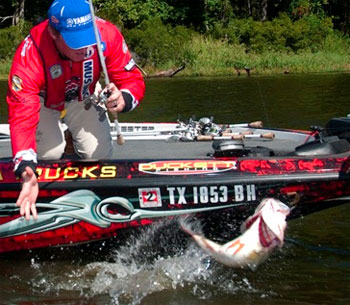Kelly Jordon: Following Summer Bass
In the hot months of summer, Kelly Jordon follows fish from shallow to deep during the day, a technique he learned during years of guiding at Lake Fork, TX.
“The key to following bass in summer is fishing an area that has some type of route, like an old roadbed, a treeline or a creek channel leading from the shallows to deep water nearby,” he said. “The bass move back and forth between shallow water and deep, so finding a shallow flat, a long point, or a cove that gradually falls into deeper depths is always worth trying.
“This movement may not be more than 100 yards, or it may be 300 to 400 yards. It depends on what the deeper water offers the bass. At the same time, if there is abundant shallow cover, particularly hydrilla or some other thick vegetation, the bass will usually stay shallow longer, too.”
Early
Jordon strongly recommends starting a July or August day of bass fishing 30 to 45 minutes before daylight because that is when fish are most likely to be in shallow water. He believes these bass may be the same fish that moved shallow to feed during the night, and they’re extremely susceptible to topwater lures like buzzbaits and frogs.
“This shallow bite doesn’t last long after the sun rises, so I really like a buzzbait because I can make long casts and cover a lot of water. I try to key on cover like logs and laydowns, lily pads and rocks, and generally in just 2 feet of water or less. I work the cover thoroughly, too, usually making two or three casts to the same object with a slow, steady retrieve to give a fish plenty of time to hit it.”
Mid-Morning
When this early shallow-water action ends, he changes to a shallow-running crankbait, often a squarebill, and begins fishing slightly deeper water down to 5 or 6 feet. He may also try flipping soft-plastics if the cover is thick enough, but his primary choice is the crankbait.
“What I’m trying to do is take advantage of all my options in relatively shallow water before the fish move. Frequently, I’ll fish the same cover with the crankbait that I fished with the buzzbait, simply because it has such a different action. Buzzbaits bring reaction strikes, while the crankbait may entice more of a feeding strike.”
Out Further
When this bite does end, Jordon moves out to 12 to 20 feet. He studies his electronics to locate steeper depth changes and possible schools of baitfish. If he has found a creek channel or even a ditch leading from the shallow water toward deeper water, this is where he concentrates. If he’s been fishing a point, he just keeps following it further and further out in the deeper water.
“I’ll really cover this water thoroughly with a deep-diving crankbait, grinding it along the bottom across any breaklines from shallow water to deep. Places I really look for are bends in a channel, and cover like rocks, stumps and flooded timber. I just keep working further out into the deeper water because I know eventually I will find the fish again.”
He looks for baitfish, especially shad, as he moves into this deeper zone. The bass will hover just below them.
Category: Fishing Tips/Techniques






